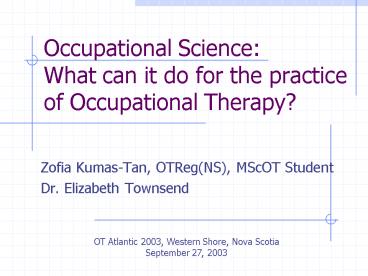Occupational Science: What can it do for the practice of Occupational Therapy - PowerPoint PPT Presentation
1 / 20
Title:
Occupational Science: What can it do for the practice of Occupational Therapy
Description:
To discuss the relationship between occupational science and occupational therapy ... 'Workers without work: Injured workers and wellbeing' (Sharon Dale Stone, 2003) ... – PowerPoint PPT presentation
Number of Views:1225
Avg rating:3.0/5.0
Title: Occupational Science: What can it do for the practice of Occupational Therapy
1
Occupational Science What can it do for the
practice of Occupational Therapy?
- Zofia Kumas-Tan, OTReg(NS), MScOT Student
- Dr. Elizabeth Townsend
OT Atlantic 2003, Western Shore, Nova
Scotia September 27, 2003
2
Learning objectives
- To consider two occupational therapy vignettes
from an occupational science perspective - To discuss the relationship between occupational
science and occupational therapy - To consider how occupational science can inform
practice
3
What is occupational science?
4
What is occupational science?
- A basic science dedicated to the study of human
occupation - An interdisciplinary science
- Qualitative and quantitative research
- The term was coined by Yerxa and her colleagues
at USC in the late 1980s
5
What is occupational science?
- What are occupations? How do we conceptualize
occupations? Why are occupations associated
narrowly with work? - What do various occupations mean to various
groups of people? How do occupations compare
amongst women and men in similar and different
cultural groups? - How do we learn to engage in occupations?
- How do occupations affect our lives? How do they
affect our health and well-being? - What determines whether occupations are valued
economically or socially?
6
Vignette 1
- Sally has a new job working with clients with
multiple sclerosis. She is searching the library
databases for information that will support her
practice. - She finds medical, occupational therapy and
occupational science resources.
7
Vignette 1
- Medical journals Botulinum toxin treatment of
painful tonic muscle spasms in multiple
sclerosis (Restivo et al., 2003) - Occupational therapy journals The effectiveness
of physical, psychological, and functional
interventions in treating clients with multiple
sclerosis a meta-analysis (Baker, 2001) - Occupational science journals Storymaking and
storytelling Making sense of living with
multiple sclerosis (Valerie Wright-St.Clair,
2003)
8
Vignette 1
- Storymaking and storytelling Making sense of
living with multiple sclerosis - What is the impact of MS on self, life,
relationships? - storymaking and storytelling as ways of making
sense of illness and managing its place in the
lived world - metaphors as a potent means to communicate
understanding when everyday language seems
otherwise insufficient
9
Vignette 1
- symbolic interactionism women who live with
multiple sclerosis seem to look through the eyes
of their illness at themselves, as a way of
making sense of how their illness is towards them
and what they do - multiple sclerosis as an aggressor, saviour,
partner, guest, adversary - On the whole, the women experienced their
illness privately.
10
Vignette 1
- Sallys new understandings
- from medical sources disease process, medical
treatments - from occupational therapy sources assessments,
interventions for multiple sclerosis - from occupational science sources the experience
of living with and making sense of multiple
sclerosis, the impact of multiple sclerosis on
occupations
11
Vignette 1
- How Sally might apply her new knowledge
- Encourage clients to share, describe their
experiences of MS - Encourage clients to use metaphor as a means of
telling their stories - Validate and normalize clients experiences by
describing other peoples experiences
12
Discussion
- In groups of 2 to 4, think about your clients,
and brainstorm questions about their occupations - WHO
- WHAT
- WHEN
- WHERE
- WHY
- (Polatajko, 2004)
13
Vignette 2
- Joe works in private practice (auto insurance),
assessing and intervening with clients injured in
MVAs. Most of his clients are on leave from
their jobs or have lost their jobs because of
their injuries. - Joe has gained a better understanding of how
injuries affect the occupational lives and
occupational wellbeing of workers by reading a
recent article Workers without work Injured
workers and wellbeing (Sharon Dale Stone, 2003)
14
Vignette 2
- But Joe is still having difficulty relaying this
information to insurance adjusters, and is unsure
how to go about advocating for his clients. - A few days ago, he came across another article
Enhancing occupational opportunities in
communities Politics Third Way and the concept
of the Enabling State (Gail Whiteford, 2003)
15
Vignette 2
- This article outlines a new political movement
(the Third Way) and model of governance (the
Enabling State) - Whiteford explores whether these represent a
model through which new occupational
opportunities can be created in communities in a
bottom up manner to enhance levels of
occupational participation. She highlights - Community led solutions
- Enabling the poor to do more
- Acknowledging space crossing boundaries
16
Vignette 2
- How might Joe use these concepts to advocate for
his clients? - How might Joe use these concepts to shape his
practice?
17
Vignette 2
- Joe might
- invite his clients to a brainstorming session,
drawing on the Workers without work paper to
stimulate discussion about occupational needs,
barriers, opportunities, etc. - advocate for implementation of new programs or
modification of existing ones, which clients
identify as necessary to occupational wellbeing - articulate the need for a new rehab/auto
insurance approach in todays changing times - collaborate with other occupational therapists,
health professionals, business/financial
analysts, academics, researchers, etc. in these
endeavours
18
Some final thoughts
- Occupational science may support occupational
therapists in their practice by informing
professional reasoning and evidence-based
practice.
19
- The Canadian Society
- of Occupational Scientists
- www.dal.ca/occscience
20
Discussion
- Why does occupational therapy need (or not need)
occupational science? - Any other thoughts? comments? questions?































